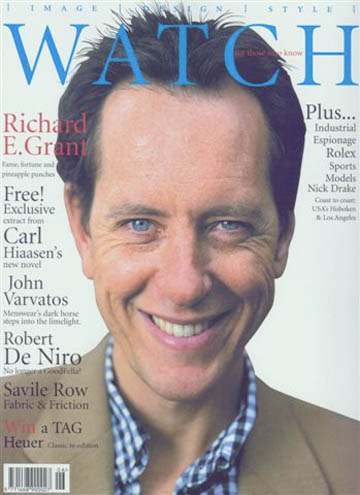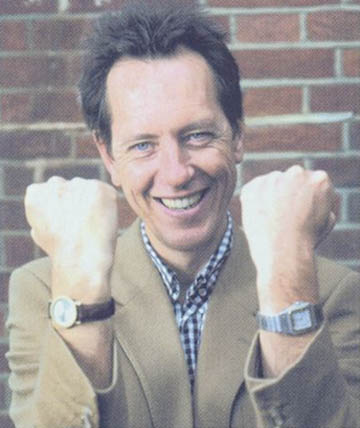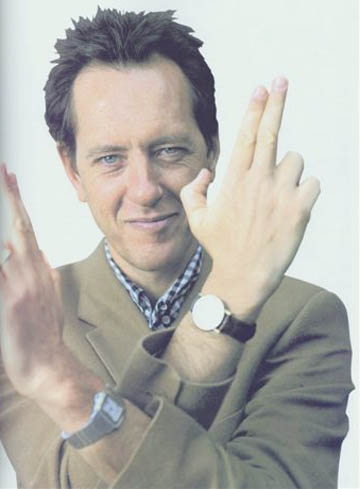With Grant And I
Watch Magazine – June/July, 2002
By Paolo Hewitt Photography: Lawrence Watson

In 1986, Richard E. Grant was handed a script entitled Withnail And I. Within a year he was a household name and about to build a career as one of Britain’s most celebrated actors. Paolo Hewitt spoke to the man who wears two watches at all times. Further on, Richard selects his all time favourite movies.
Thursday, midday at the cafe in Harvey Nichols where the actor Richard E. Grant sits waiting at a table. As I approach, Grant rises to meet me and it is then that I notice he is wearing two watches on either wrist. One is set to British summertime, the other to the time in Swaziland.
“I would wear ten on each arm if my wife wouldn’t shoot me,” he enthuses, settling down. “I love watches. My wife once gave me a Cartier watch and I would love a Patek Philippe. I have a box of watches at home. It all goes back to when I was seven and I was given a watch. My parents had been to Switzerland and I got one as a birthday present. I will always remember the thrill of that.”
Right now, Richard E. Grant’s profile is neither high nor low. Which is how it has been for many years. This is an actor who bucks modern trends and tends not to draw attention to himself in the media. He prefers to concentrate on the delivery of good work in the firm belief that from there all things will follow. So far this low key approach has proved correct. He has worked continuously in the cinema for the last sixteen years.
His latest film is the Robert Altman-directed Gosford Park which is still holding well at the box office. No wonder. The film is classy, extremely well made and features a plethora of name British actors – Alan Bates, Maggie Smith, Helen Mirren, Clive Owen, to name but four. Yet for many people, it is Grant’s icy cold butler that steals the show.
He is now preparing to play opposite Richard Roxburgh in a new version of Arthur Conan Doyle’s Hound Of the Baskervilles before moving on to play a major role in a film examining Napoleon’s final years. Interestingly, the film will be directed by Antoine De Cadenet, best known in the UK as the presenter of Eurotrash.
“In France,” Richard explains, “Antoine is known as a film director, an actor and a writer. Over here he is just known as the Eurotrash guy, There is so much more to him.”
This comment prompts me to ask him if he has noted the English tendency to be highly suspicious of anyone who doesn’t stay in the box assigned to them.

Grant smiles and nods knowingly ” I found that out when I published my two books, With Nails and By Design, that you mustn’t get out of your place. Journalists really don’t like it.”
Richard’s first book, With Nails, contained the diary he kept during the making of several of his films, By Design is a novel set in Hollywood. The heavy critical sniping afforded the latter project wasn’t strong enough, however, to dent his belief in his writing talents.
He has just finished a screenplay about his father’s life — he was a well-regarded Minister Of Education in Swaziland — and is now raising funds for the film. He also has permission to film in his home country of Swaziland where he was born on May 6th, 1957. He describes the country of his childhood as an, “Equatorial Ealing, circa 1950. They only got television in Swaziland at the end of the ’70s. So it was a time warp, last-gasp-of-empire, luxurious, easy colonial lifestyle.”
His school was called Waterford and Nelson Mandela’s children were contemporaries. He enjoyed his schooldays immensely so much so that he is now a trustee of the school and an enthusiastic fund-raiser of bursaries for cash-strapped but academically gifted kids to attend the school. (Ebel watches very kindly agreed to donate a Ladies Beluga timepiece to this charity.)
Richard got the acting bug early He acted in school plays, the local theatre, anything that would take him. But his chances of shaping a career out of acting in Swaziland remained non-existent.
“Saying that you wanted to be an actor in Swaziland,” he reveals, “was as daft as saying you wanted to be an astronaut. The chances were zero. I’m just so grateful that it worked out.”
Grant’s obsession and drive was sustained by that great rush of American movies made between 1969 and 1977 and directed by an iconoclastic generation of new directors such as Coppola, Scorsese, Altman and Bob Rafelson. Their work was dominated by one impulse –- to make ground breaking movies. The formation of this new type of cinema followed Grant’s admission to Capetown University to study the theatre.
He passed his degree and in 1982, he came to England to find out if he had any acting talent. He was twenty-five years old.
“I had two suitcases, a couple of boxes of cassettes, a Walkman, a phone number and this blind hope that I could find my fortune here,” he recalls. ” I gave myself ten years. If it didn’t work out I was going to go home and make pineapple punches in a bar.”

To support himself Grant took on a variety of second-hand jobs – painting and decorating, driving – whilst in his spare time, he found acting work in the usual outlets of fringe work, repertory tours, and Shakespeare in Regents Park. 1986, he was handed a script which would literally change his life. It was called Withnail and I.
“They gave me this script which had no stars, no women and no car chases,” he says. “Meanwhile the biggest film of that year was the action adventure film, Crocodile Dundee.”
The film boasted many firsts. It was Grants first lead role in a film. His co-star, Paul MaGann had never acted in a movie, whilst Bruce Robinson, had never directed before. A promising start.
“From our point of view,” Richard recalls, “it was a real us against the world mentality that we developed and we had a very good time making it. I remember the crew saying to all of us, it will be a very long time before you work on a movie as good as this one. It was true. The feeling from the crew, as well as making a film which nobody really wanted to he made, was really good. I became life-long friends with so many people from that film.”
On its UK release, Withnail and 1 lasted a month at London’s Odeon Haymarket cinema and then disappeared from view.
Then it came out on video. From there, an appreciative audience gave it what every work of art most desires – massive word of mouth recommendation. It was re-released in the cinema to huge critical and commercial acclaim, has recently been made available on DVD and is the subject of numerous internet sites.
Grant followed the movie with Bruce Robinson’s next protect, How To Get Ahead In Advertising. It was seen as Withnail’s follow up and it bombed. But Grant didn’t. His spot-on portrayals of uptight men, constrained by back ground and class yet forever suggesting a latent menace, has been viewed favourably by name directors, many of whom inspired him so much in his youth.
He worked with Martin Scorsese on Age Of Innocence, his hero Francis Ford Coppola on Bram Stoker’s Dracula, and has featured in three Robert Altman movies: The Player, Pret A Porter and Gosford Park.
Yet once his work is in the public domain, Grant walks away from it, ignores it. The work is now out of his control.
“Seeing yourself up there so large,” he explains, “it is a contradiction because on the one hand you are saying, Give the role to me over X number of people. Yet when you watch it you always think, how on earth did I get this job in the first place? Paranoia shoots in. Then you have to think to yourself well having done it for twenty years now, you obviously do some thing that other people think is alright or else they wouldn’t employ you.”
He glances at his London watch and his piercing blue eyes adopt a pleading look. Time to go, time to disappear, a time still ruled by the need to do good, to do well.
Watch magazine would like to Thank Ebel for their donation to Richard E. Grant’s charity and to John Lobb for their full support and co-operation.
Richard writes about his all time top movies here.








